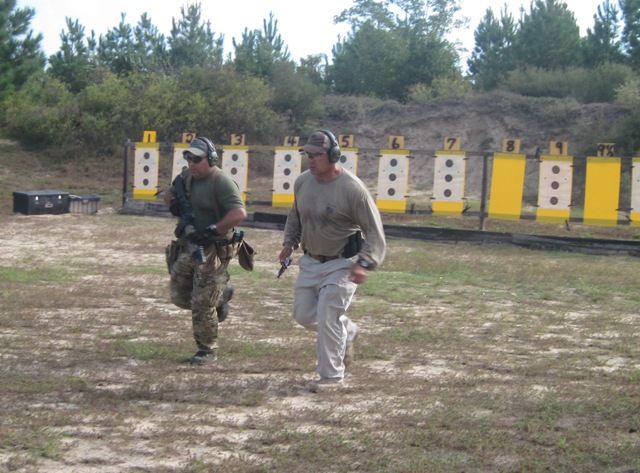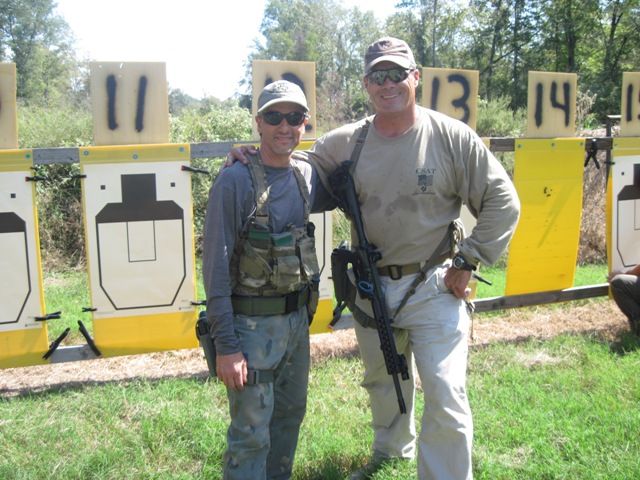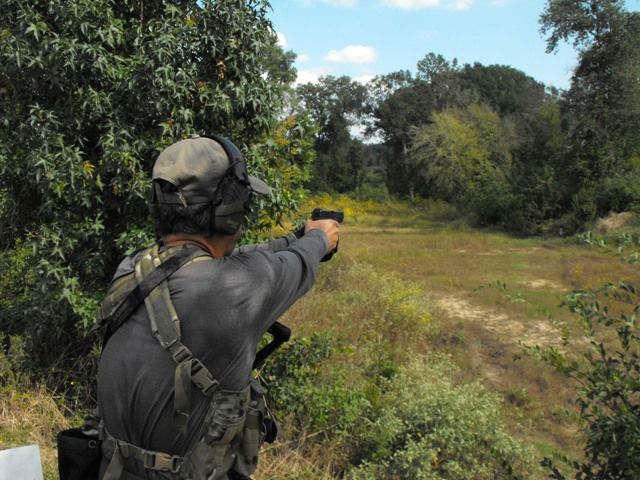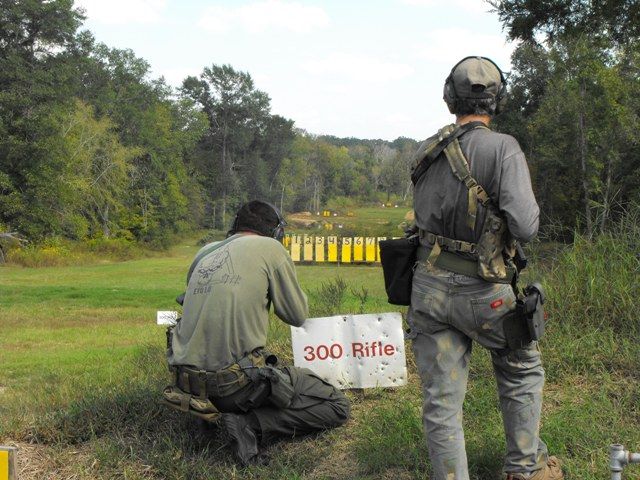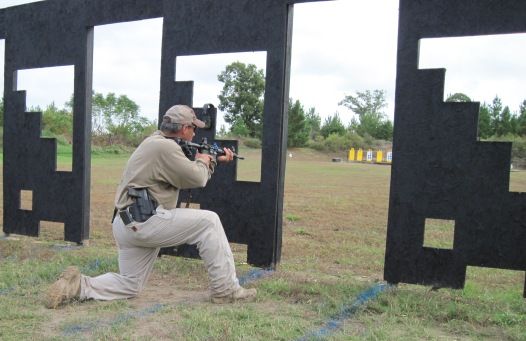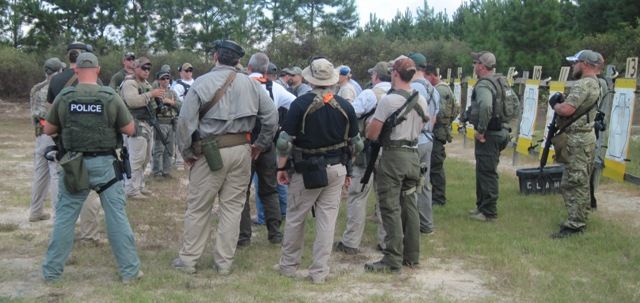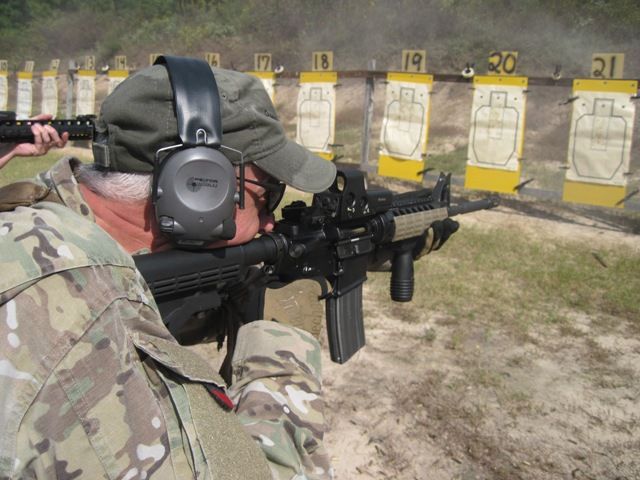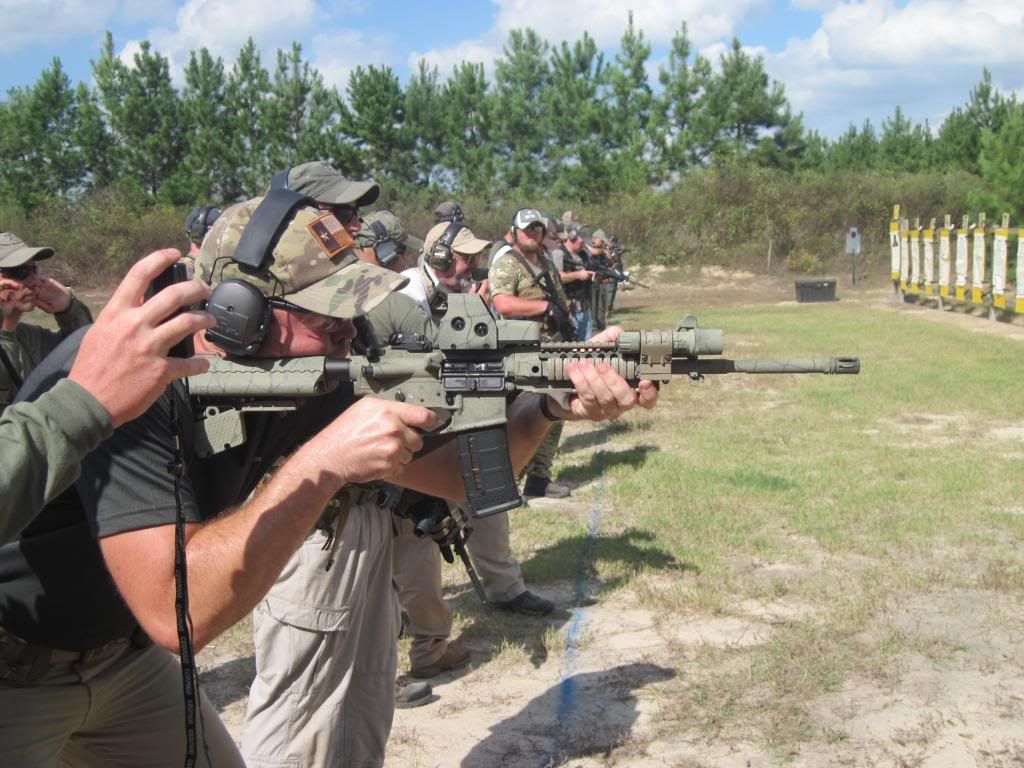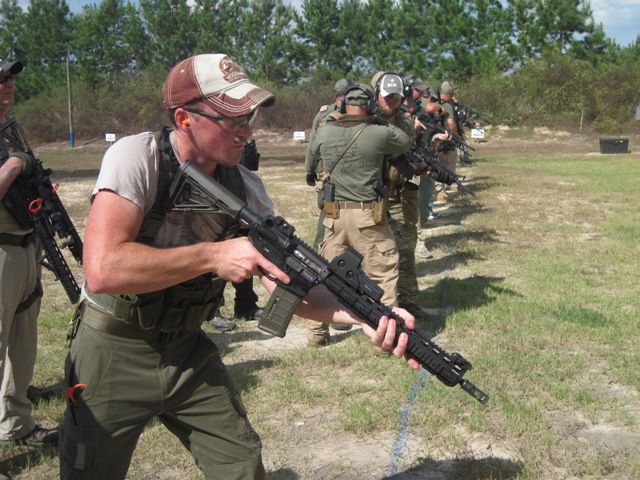Combat Shooting and Tactics (CSAT) Tac Rifle Instructor Course
Date: October 8-14th, 2012
Location: CSAT ranges in Nacogdoches, TX
Weather: Moderate temps, partly cloudy most days.
Round Count: ~1000 rifle, ~100 pistol
Instructor: Paul Howe
Course info available at: http://www.combatshootingandtactics.com
This class was an open enrollment class and was full with 13 instructor students. It consisted primarily of LE, with a couple mil and civilians mixed in. Everyone came ready to learn with great attitudes. We were split into two teams with guys who had completed the Tac Pistol Instructor course as team leaders. Everyone stayed at the CSAT facility and this made it easy for us to gel with our teams early on.
Paul has over 20 years in the U. S. Military and over 10 years in the Army’s elite Special Operations Forces. During his tour in Special Operations, Paul spent two years as a Senior Instructor in various topics, including Basic Rifle Marksmanship. After retirement, Paul has also done contract work in both the military and law enforcement community and still maintains close ties with those communities. Paul is very approachable and does everything he can do to answer any questions asked. Many times when he was answering questions or demonstrating TTP’s, it was obvious that this was a man who has mastered his subject matter at the highest level and performed from a sub conscience skill level. It was impressive to say the least.
The purpose of this class was to instruct students on the safe employment of Tactical Rifle training for Tactical, Patrol and Range personnel. At the end of the course, students would be able to teach a comprehensive two day operator course on the use of the tactical rifle. The course addressed the following major topics:
Safety
Safe set-up and instruction
Surgical shooting (Rifle/Pistol)
Discrimination
Weapon Zero
Standard and Non-Standard Shooting Positions
2 person Techniques
Instructional Techniques
Shooting Plan Development
Dealing with Problem Shooters
Target Selection
Practical Instruction
Facility:
Paul’s facility is awesome to say the least. There are bunk room type accommodations with a fridge and microwave, laundry, showers etc. A classroom, gun room and maintenance room along with a workout area. The range is laid out well with a pistol range, 100 yard rifle range, car junkyard range with steel and movers and his shoot house in one central area. The shoot house, which is essentially and deep U-shaped bay with a long center hallway and rooms on both sides allowing you to shoot into the berms, was simple, but effective. Then about 50 yrds away from that is Sniper Hill, which has rifle targets, both paper and steel, out to 700 yrds. Also found on that range is an obstacle course and the very challenging Scrambler course.
Weather:
Weather for the week was very favorable for long days on the range and a welcome break from the sweltering Texas heat. Day 1 started out in the mid 60’s and stayed cool until mid afternoon when it peaked at about 82. It gradually heated up over the next few days to about a high of 88. Again most days were partly cloudy and overcast so no heat related distractions occurred. Finally, on the weekend when students arrived, Saturday was great with a little more sun out and the need for sunscreen with a little drizzle on Sunday, but nothing that interrupted training.
Guns and Gear:
I was running a BCM mid length upper on a Colt lower with a T1 micro and Troy rear BUIS for the rifle and a S&W M&P 9 for handgun. I also used a BFG SOC-C belt with suspenders and HSGI Taco mag pouches and a Safariland ALS holster for Line 1. Line 2 was an LBT 6094 PC w/cumberbund with Tacos, med pouch and a couple TQ’s. I had no issues with my rifle or gear. Everyone had an AR type and there were rifles from PWS, LWRC, Wilson Combat, Colt, Larue, Bushmaster, and a few others represented. A mixture of Aimpoints, EoTechs and Iron sigths were used for sighting systems. In the instructor class no one had any major issues that were weapons related. Ammunition ran the gamut as well. The only malfunctions that we noticed, was a lot of PMC 55gr that seemed to be causing issues. The student class also all had AR type rifles running the spectrum of manufacturers. Optics again was a mixture of Aimpoint, EoTech, Leupold and Irons. There was one Franken gun in the bunch that went down midday on T1. He finished the class out with a loaner.
Day 1: We all met at the classroom and went through the admin portion and initial lecture on safety, followed by a course overview and team assignments. We then went to the range and began shooting. We started with confirming zeros for both irons and optics, with Paul going through his methods for quickly getting a student on paper at 7yrds and then fine tuning at 100 yrds. Paul does prefer the 100 yrd zero to others, but encouraged students to understand that our goal was to be able to use the tactical rifle from 0 – 300 yrds and each shooter should know what his rifle will do at those distances. We then worked on position shooting. Paul stressed building your position and keeping hand position, stock weld, breathing, etc. the same regardless of whether you are in the prone, kneeling or standing. The position for 100 yrds and further was prone, 75 and 50 yard distances from kneeling and 25 yrds and in, standing. We then worked the 7rd line drills, which included the drills from his rifle standards. The usual singles, doubles, 2 targets and failure drills were all worked. We then finished the day shooting the full rifle standards course to begin qualifying instructor students. We gained 4 instructors of 13 on the first round, including myself. Woo hoo…glad to get that out of the way. We then had a brief AAR for the day and finished up at about 1700 hrs. Several students stayed after class and shot the standards again with two more passing that evening.
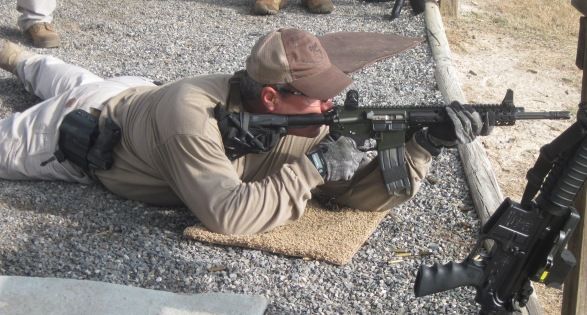
Paul demonstrating the prone position
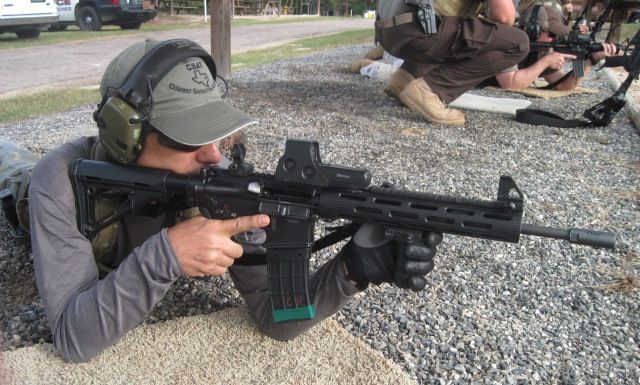
Doc Lucci from Wild River Ranch in the prone
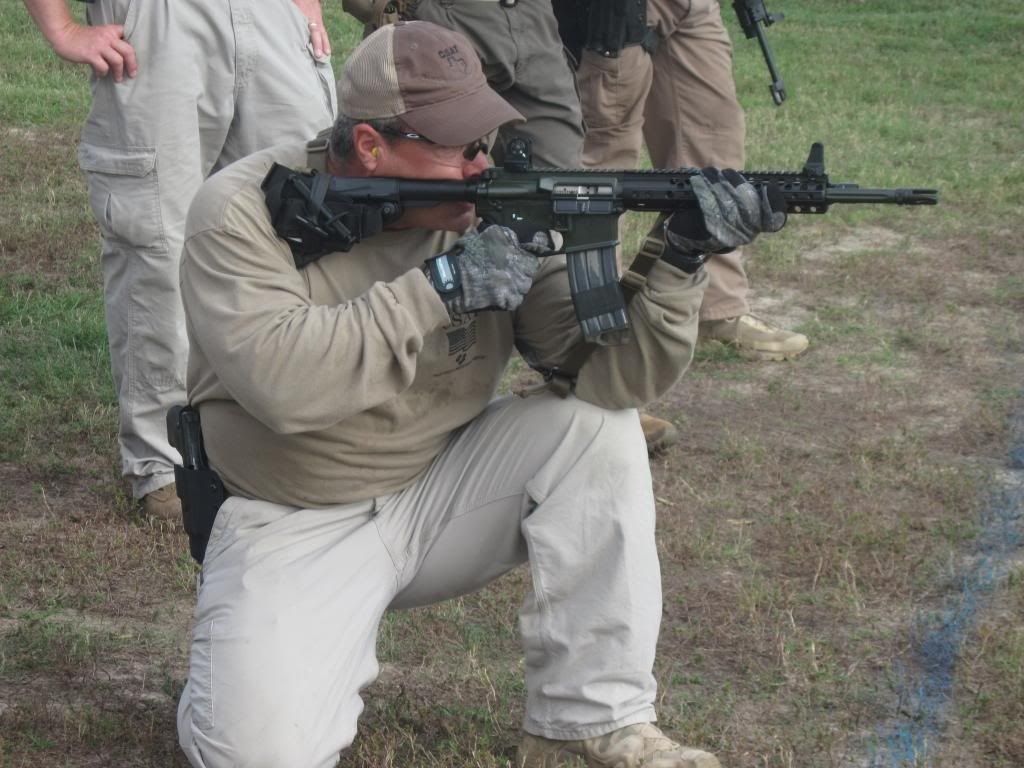
Paul demonstrates the kneeling position
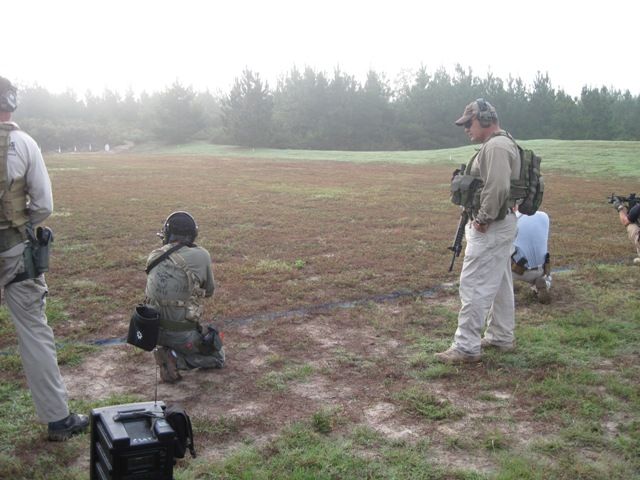
Paul critiques a shooters kneeling position
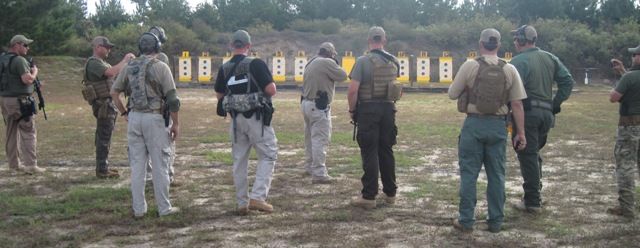
Paul demonstrates the standing at 25 yrds
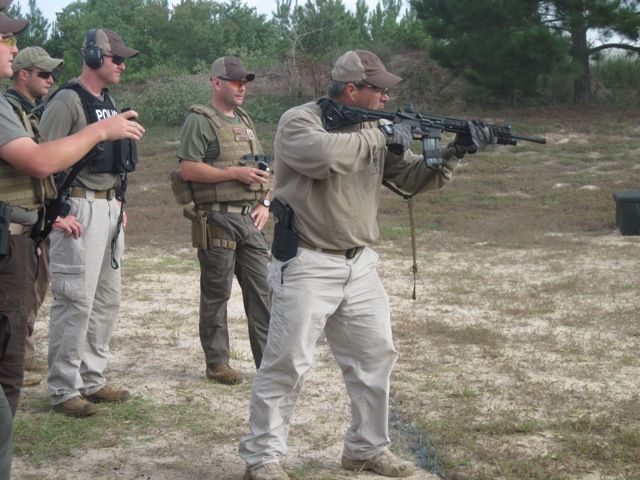
Paul demonstrates the speed drills at the 7yrd line
Day 2: We checked zeros quickly, started rotating instructor students in to run the line and shot the standards again for those who had not yet passed. We picked up another 6 instructor students on this go around with one lone student who was not yet qualified. We then moved on to Paul’s surgical shooting drill. Paul explained again the importance of the position of your rifle being low enough that you can see what is ahead of you and the hands of any potential threats. He reinforced the idea that we have to identify and discriminate all threats before we engage. He also emphasized that we should only shoot as fast as the target dictates. Very small targets require a more precise shot than a larger target with larger available area. After Paul informed us that the hostage target was in fact his daughter, we all slowed down…hahaha. We also went over mechanical offset and how target position can play into that, such as a target that has fallen or is lying down and you may be holding your dot or irons on the hostage to strike the threat where you want. Again, know what your rifle will do with regards to mechanical offset at various distances or if you rifle is positioned at any angle that is not straight up and down.
During demo’s he also showed us his reasoning for doing the first demo slow, so that students can see perfect mechanics, then doing it fast at what he calls “operational speed” which meets the standard and gives students a full speed example to follow and then slow again, so the students get another visual picture of perfect mechanics before doing the drill themselves. I would remind everyone that this course is aimed at teaching a first level shooting course. We should be more concerned with accuracy and proper mechanics than racing the clock or the student next to us. Speed will develop with repetitions. Paul constantly reinforced that accurate hits are more important than speed. Paul purposefully shoots slower during this class to reinforce this concept. However, in the past some people have confused his method for demonstrating and began to think that Paul is slow. Hahaha. Paul is not slow! He is simply demonstrating the level required to meet the standard. The adage that “You can’t miss fast enough to win a gunfight!” applies here. While his personality is calm, collected and friendly, his Mindset is 100% offense, a very aggressive offense at that. If you are a bad guy, Paul is not looking to scare you or suppress your fire with fast misses. He is going to kill you on the first shot! Even if you aren’t dead with a new hole or two in your body, that will suppress your fire, reset your OODA loop and cause your friends to either go away or get suppressed like you did. Paul is truly a Killer Whale, in a sea of baitfish. Awesome, I love it!
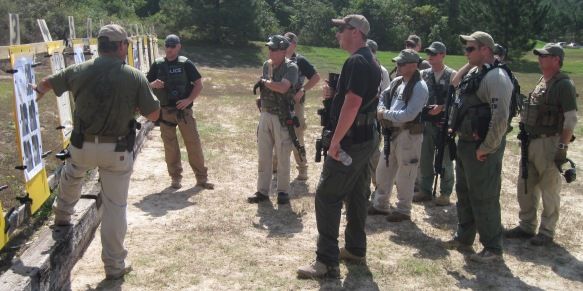
Paul explaining some of the finer points of the drills
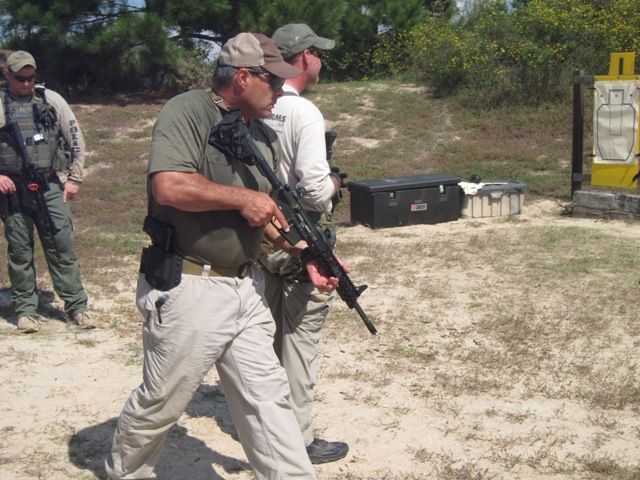
Paul moving around Student “Barricades” during surgical shooting drill
Date: October 8-14th, 2012
Location: CSAT ranges in Nacogdoches, TX
Weather: Moderate temps, partly cloudy most days.
Round Count: ~1000 rifle, ~100 pistol
Instructor: Paul Howe
Course info available at: http://www.combatshootingandtactics.com
This class was an open enrollment class and was full with 13 instructor students. It consisted primarily of LE, with a couple mil and civilians mixed in. Everyone came ready to learn with great attitudes. We were split into two teams with guys who had completed the Tac Pistol Instructor course as team leaders. Everyone stayed at the CSAT facility and this made it easy for us to gel with our teams early on.
Paul has over 20 years in the U. S. Military and over 10 years in the Army’s elite Special Operations Forces. During his tour in Special Operations, Paul spent two years as a Senior Instructor in various topics, including Basic Rifle Marksmanship. After retirement, Paul has also done contract work in both the military and law enforcement community and still maintains close ties with those communities. Paul is very approachable and does everything he can do to answer any questions asked. Many times when he was answering questions or demonstrating TTP’s, it was obvious that this was a man who has mastered his subject matter at the highest level and performed from a sub conscience skill level. It was impressive to say the least.
The purpose of this class was to instruct students on the safe employment of Tactical Rifle training for Tactical, Patrol and Range personnel. At the end of the course, students would be able to teach a comprehensive two day operator course on the use of the tactical rifle. The course addressed the following major topics:
Safety
Safe set-up and instruction
Surgical shooting (Rifle/Pistol)
Discrimination
Weapon Zero
Standard and Non-Standard Shooting Positions
2 person Techniques
Instructional Techniques
Shooting Plan Development
Dealing with Problem Shooters
Target Selection
Practical Instruction
Facility:
Paul’s facility is awesome to say the least. There are bunk room type accommodations with a fridge and microwave, laundry, showers etc. A classroom, gun room and maintenance room along with a workout area. The range is laid out well with a pistol range, 100 yard rifle range, car junkyard range with steel and movers and his shoot house in one central area. The shoot house, which is essentially and deep U-shaped bay with a long center hallway and rooms on both sides allowing you to shoot into the berms, was simple, but effective. Then about 50 yrds away from that is Sniper Hill, which has rifle targets, both paper and steel, out to 700 yrds. Also found on that range is an obstacle course and the very challenging Scrambler course.
Weather:
Weather for the week was very favorable for long days on the range and a welcome break from the sweltering Texas heat. Day 1 started out in the mid 60’s and stayed cool until mid afternoon when it peaked at about 82. It gradually heated up over the next few days to about a high of 88. Again most days were partly cloudy and overcast so no heat related distractions occurred. Finally, on the weekend when students arrived, Saturday was great with a little more sun out and the need for sunscreen with a little drizzle on Sunday, but nothing that interrupted training.
Guns and Gear:
I was running a BCM mid length upper on a Colt lower with a T1 micro and Troy rear BUIS for the rifle and a S&W M&P 9 for handgun. I also used a BFG SOC-C belt with suspenders and HSGI Taco mag pouches and a Safariland ALS holster for Line 1. Line 2 was an LBT 6094 PC w/cumberbund with Tacos, med pouch and a couple TQ’s. I had no issues with my rifle or gear. Everyone had an AR type and there were rifles from PWS, LWRC, Wilson Combat, Colt, Larue, Bushmaster, and a few others represented. A mixture of Aimpoints, EoTechs and Iron sigths were used for sighting systems. In the instructor class no one had any major issues that were weapons related. Ammunition ran the gamut as well. The only malfunctions that we noticed, was a lot of PMC 55gr that seemed to be causing issues. The student class also all had AR type rifles running the spectrum of manufacturers. Optics again was a mixture of Aimpoint, EoTech, Leupold and Irons. There was one Franken gun in the bunch that went down midday on T1. He finished the class out with a loaner.
Day 1: We all met at the classroom and went through the admin portion and initial lecture on safety, followed by a course overview and team assignments. We then went to the range and began shooting. We started with confirming zeros for both irons and optics, with Paul going through his methods for quickly getting a student on paper at 7yrds and then fine tuning at 100 yrds. Paul does prefer the 100 yrd zero to others, but encouraged students to understand that our goal was to be able to use the tactical rifle from 0 – 300 yrds and each shooter should know what his rifle will do at those distances. We then worked on position shooting. Paul stressed building your position and keeping hand position, stock weld, breathing, etc. the same regardless of whether you are in the prone, kneeling or standing. The position for 100 yrds and further was prone, 75 and 50 yard distances from kneeling and 25 yrds and in, standing. We then worked the 7rd line drills, which included the drills from his rifle standards. The usual singles, doubles, 2 targets and failure drills were all worked. We then finished the day shooting the full rifle standards course to begin qualifying instructor students. We gained 4 instructors of 13 on the first round, including myself. Woo hoo…glad to get that out of the way. We then had a brief AAR for the day and finished up at about 1700 hrs. Several students stayed after class and shot the standards again with two more passing that evening.

Paul demonstrating the prone position

Doc Lucci from Wild River Ranch in the prone

Paul demonstrates the kneeling position

Paul critiques a shooters kneeling position

Paul demonstrates the standing at 25 yrds

Paul demonstrates the speed drills at the 7yrd line
Day 2: We checked zeros quickly, started rotating instructor students in to run the line and shot the standards again for those who had not yet passed. We picked up another 6 instructor students on this go around with one lone student who was not yet qualified. We then moved on to Paul’s surgical shooting drill. Paul explained again the importance of the position of your rifle being low enough that you can see what is ahead of you and the hands of any potential threats. He reinforced the idea that we have to identify and discriminate all threats before we engage. He also emphasized that we should only shoot as fast as the target dictates. Very small targets require a more precise shot than a larger target with larger available area. After Paul informed us that the hostage target was in fact his daughter, we all slowed down…hahaha. We also went over mechanical offset and how target position can play into that, such as a target that has fallen or is lying down and you may be holding your dot or irons on the hostage to strike the threat where you want. Again, know what your rifle will do with regards to mechanical offset at various distances or if you rifle is positioned at any angle that is not straight up and down.
During demo’s he also showed us his reasoning for doing the first demo slow, so that students can see perfect mechanics, then doing it fast at what he calls “operational speed” which meets the standard and gives students a full speed example to follow and then slow again, so the students get another visual picture of perfect mechanics before doing the drill themselves. I would remind everyone that this course is aimed at teaching a first level shooting course. We should be more concerned with accuracy and proper mechanics than racing the clock or the student next to us. Speed will develop with repetitions. Paul constantly reinforced that accurate hits are more important than speed. Paul purposefully shoots slower during this class to reinforce this concept. However, in the past some people have confused his method for demonstrating and began to think that Paul is slow. Hahaha. Paul is not slow! He is simply demonstrating the level required to meet the standard. The adage that “You can’t miss fast enough to win a gunfight!” applies here. While his personality is calm, collected and friendly, his Mindset is 100% offense, a very aggressive offense at that. If you are a bad guy, Paul is not looking to scare you or suppress your fire with fast misses. He is going to kill you on the first shot! Even if you aren’t dead with a new hole or two in your body, that will suppress your fire, reset your OODA loop and cause your friends to either go away or get suppressed like you did. Paul is truly a Killer Whale, in a sea of baitfish. Awesome, I love it!

Paul explaining some of the finer points of the drills

Paul moving around Student “Barricades” during surgical shooting drill


